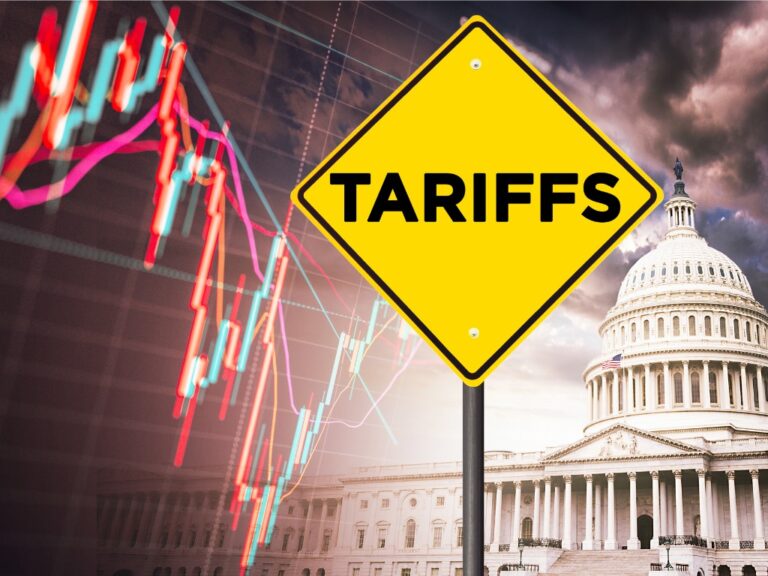Facing Trump’s Tariffs: 10 Essential Steps for General Counsel
By Charles Baldwin and Gabby Supak
July 2, 2025

Charles Baldwin, a partner at Brooks Pierce in the port city of Wilmington, North Carolina, uses his broad experience in cross-border transactions to advise businesses on international trade, venture capital, and U.S. market entry. He may be reached at cbaldwin@brookspierce.com.
Gabby Supak, an associate at Brooks Pierce, is involved in international trade and business litigation matters. She may be reached at gsupak@brookspierce.com.
Published in Today’s General Counsel, September/October 2025
There was considerable debate at the outset over whether the Trump administration’s tariffs would pose only a short-term challenge or have more enduring consequences. With legal rulings on their validity still pending, it’s becoming increasingly evident that these heightened tariffs and the uncertainty surrounding them are here to stay. General counsel must move quickly to ensure their organizations are well-positioned to navigate the evolving landscape of Trump’s tariffs.
10 Proactive Steps for GCs:
1. Talk to Your CFO/Director of Finance and Assess Risks of Tariff Exposure: It’s critical to determine the potential impacts and risks of exposure before establishing a suitable plan. Getting input from finance and business personnel is key.
2. Prioritize Vendors, Clients, and Key Contracts: Where are the impacts from tariffs most likely to affect your company? Start with the most material relationships and agreements. How might they affect your pricing, distributors, and the ultimate consumer? If you are unable to deliver the product, will someone’s production lines be halted?
3. Determine Whether You’re Facing New or Old Tariffs: Are the tariffs identified as material newly imposed tariffs by the Trump administration, or are they antidumping (AD) or countervailing duties (CVD) tariffs imposed under prior administrations? The AD/CVD tariff levels are known. In contrast, the imposition of tariffs by executive order outside of treaty frameworks means that the levels of the new tariffs may remain unpredictable and depend on political as well as economic factors. These tariffs are also likely to vary over time based on the administration’s actions and bilateral agreements.
4. Follow General Contract Law Principles in the Absence of Binding Case Law and Statutes: Until these matters work their way through the courts and legislative bodies, economic practicality and the general principles of contract law will need to guide decisions. An example is a manufacturer hitting “pause” on most contracts for purchase or sale in order to reestablish cost of goods and a new Manufacturer’s Suggested Retail Price (MSRP). Contracts and pricing may require a reset. Review provisions and include mechanisms to address tariffs, including changing the destination of delivery, tariff responsibility, surcharges, etc.
5. Consult with In-House Counsel and Outside Tariffs Counsel: Legal input may be helpful on areas such as risk assessment, mitigation, and alternative approaches. Should standard agreements and purchase orders be updated to address tariffs? Consider updates to the provisions mentioned above.
6. Consider Tariff Reduction Measures: These vary widely in nature and scope. Examples include seeking alternate suppliers, establishing or relocating a foreign plant or operation, or modifying supply chains. The uncertain duration of the new tariffs, enacted under a declared emergency, clouds this analysis.
Other measures include tariff deferral programs, such as the use of a foreign trade zone or bonded warehouse. As a broad generalization, goods imported into such facilities are not considered to enter the U.S. customs territory, and tariffs are not owed until withdrawn for U.S. consumption. If re-exported, the goods may never enter the U.S. customs territory and be subject to payment of tariffs.
Tariffs also may be reduced by reclassification of goods under the U.S. Harmonized Tariff Schedule. These include, among others:
- Changing the base tariff classification of goods by focusing on the market or primary intended use rather than discrete technical function, or vice versa. However, this will not avoid the new countrywide tariffs of 10-30%.
- Changing the foreign content of goods.
- Making the seller the importer of record in cases where formerly goods were shipped directly to the buyer. This move reduces the declared value of goods on which the tariff is calculated.
- Importing or exporting goods at an earlier or later stage in the manufacturing process.
7. Determine Strategy: Based upon the analysis of risk and options, determine strategy, actions needed, and timing. Any new strategy may involve legal and practical challenges. Consider:
- Does the strategy make sense? Does it pass the laugh test?
- Who has the authority to deal? What approvals are needed?
- Where are the hidden risks? Find those risks and address them.
8. Have Tough Discussions with Key Vendors and Clients: If the strategy involves pausing or terminating contracts or relationships, these will be tough discussions. Consider mutual interests and solutions. In long-term relationships, it may be possible to restructure, extend terms or grant mutual concessions.
9. Execute the Strategy: Businesses that execute their tariff response strategies decisively may gain advantages over those that hesitate during periods of trade policy uncertainty.
10. Monitor Developments and Reassess: Assign responsibility for monitoring developments. The specific tariff levels, countries, and economic sectors affected will gain greater clarity with time. Bilateral agreements, if reached, will go a long way in this regard. Keep track of the new tariffs paid in case they are ruled unconstitutional and refunded.
Must read intelligence for general counsel
Subscribe to the Daily Updates newsletter to be at the forefront of best practices and the latest legal news.
Daily Updates
Sign up for our free daily newsletter for the latest news and business legal developments.




